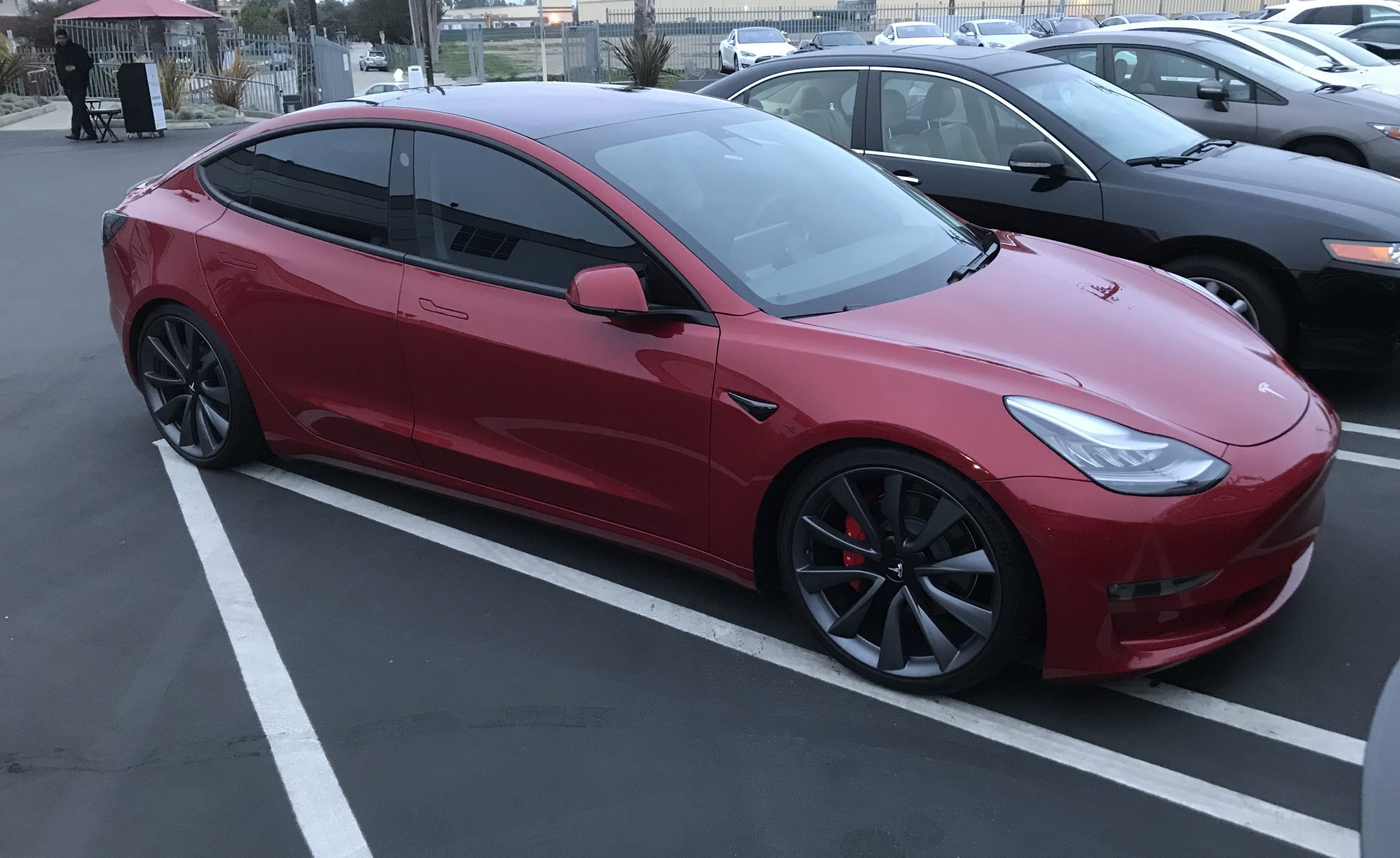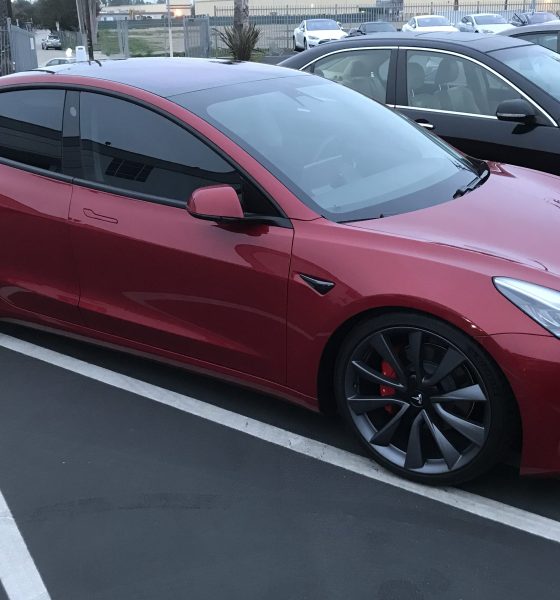

News
Tesla will produce AWD Model 3 Performance before dual-motor only version
Elon Musk recently announced that Tesla would be prioritizing the production of the AWD Model 3 Performance over the regular dual-motor variant of the compact electric car.
In an update on Monday, Musk responded to one of his Twitter followers who inquired if Tesla would only produce the AWD Model 3 Performance in July. According to Musk, rolling out the Performance version before the regular AWD variant would ensure that the company does not incur negative margins on the Model 3.
Yes, AWD P first and then AWD. Production costs are always high when line first gets going, so we have to sell higher price versions first or each car will have very negative margins. As production efficiency rises, we can make lower cost versions & not lose money.
— Elon Musk (@elonmusk) May 29, 2018
Musk’s emphasis on the company’s profitability has been particularly notable during the past few months. Back in April, Musk responded to an article from The Economist which predicted that Tesla would need to raise $2.5-$3 billion this year. According to Musk’s response, Tesla would not need to raise any money this year because the company would be profitable in the third or fourth quarter. Musk reiterated this statement during Tesla’s Q1 2018 earnings call.
As a means to achieve profitability, Tesla needs to optimize the production of the Model 3. In a tweet earlier this month, Musk noted that Tesla is prioritizing the Model 3’s higher-priced versions in order to smooth out cash flow and achieve target cost. Musk further added that if Tesla opted to jump immediately to the production of the Model 3’s $35,000 standard-range RWD variant, Tesla would “ lose money and die.”
With production, 1st you need achieve target rate & then smooth out flow to achieve target cost. Shipping min cost Model 3 right away wd cause Tesla to lose money & die. Need 3 to 6 months after 5k/wk to ship $35k Tesla & live.
— Elon Musk (@elonmusk) May 21, 2018
Back in April, Elon Musk stated that the AWD dual-motor version of the Model would start production in July. Musk also noted that the white seats option — a popular configuration for the Model S and Model X — would probably be available for the compact electric car around the same time. Musk stated, however, that Tesla would have to hit a steady production rate of 5,000 Model 3 per week before it could start offering new options to reservation holders.
These new options ultimately got revealed this May, when Musk opened orders for the Model 3’s Performance and AWD versions. The two new variants are pricier than the first production long-range RWD Model 3, with the long-term AWD option costing an additional $5,000 and the Performance variant costing $78,000 with all options except Autopilot. A batch of configuration invites for the vehicles went out last week.
The two vehicles provide better performance over the RWD Model 3, with the AWD version having a 0-60 mph time of 4.5 seconds. The Performance Model 3, which automatically comes with AWD, is a whole new beast, with a top speed of 155 mph and a 0-60 mph time of 3.5 seconds. Musk further stated that the Model 3 Performance would be 15% faster than a BMW M3 on a track.
For now, Model 3 reservation holders who would like to purchase the regular AWD variant would have to wait a little bit more before their vehicles are manufactured. By July, however, the auto world would see exactly how the most powerful Model 3 in Tesla’s lineup compares to its competitors.

News
Tesla starts showing how FSD will change lives in Europe
Local officials tested the system on narrow country roads and were impressed by FSD’s smooth, human-like driving, with some calling the service a game-changer for everyday life in areas that are far from urban centers.

Tesla has launched Europe’s first public shuttle service using Full Self-Driving (Supervised) in the rural Eifelkreis Bitburg-Prüm region of Germany, demonstrating how the technology can restore independence and mobility for people who struggle with limited transport options.
Local officials tested the system on narrow country roads and were impressed by FSD’s smooth, human-like driving, with some calling the service a game-changer for everyday life in areas that are far from urban centers.
Officials see real impact on rural residents
Arzfeld Mayor Johannes Kuhl and District Administrator Andreas Kruppert personally tested the Tesla shuttle service. This allowed them to see just how well FSD navigated winding lanes and rural roads confidently. Kruppert said, “Autonomous driving sounds like science fiction to many, but we simply see here that it works totally well in rural regions too.” Kuhl, for his part, also noted that FSD “feels like a very experienced driver.”
The pilot complements the area’s “Citizen Bus” program, which provides on-demand rides for elderly residents who can no longer drive themselves. Tesla Europe shared a video of a demonstration of the service, highlighting how FSD gives people their freedom back, even in places where public transport is not as prevalent.
What the Ministry for Economic Affairs and Transport says
Rhineland-Palatinate’s Minister Daniela Schmitt supported the project, praising the collaboration that made this “first of its kind in Europe” possible. As per the ministry, the rural rollout for the service shows FSD’s potential beyond major cities, and it delivers tangible benefits like grocery runs, doctor visits, and social connections for isolated residents.
“Reliable and flexible mobility is especially vital in rural areas. With the launch of a shuttle service using self-driving vehicles (FSD supervised) by Tesla in the Eifelkreis Bitburg-Prüm, an innovative pilot project is now getting underway that complements local community bus services. It is the first project of its kind in Europe.
“The result is a real gain for rural mobility: greater accessibility, more flexibility and tangible benefits for everyday life. A strong signal for innovation, cooperation and future-oriented mobility beyond urban centers,” the ministry wrote in a LinkedIn post.
News
Tesla China quietly posts Robotaxi-related job listing
Tesla China is currently seeking a Low Voltage Electrical Engineer to work on circuit board design for the company’s autonomous vehicles.

Tesla has posted a new job listing in Shanghai explicitly tied to its Robotaxi program, fueling speculation that the company is preparing to launch its dedicated autonomous ride-hailing service in China.
As noted in the listing, Tesla China is currently seeking a Low Voltage Electrical Engineer to work on circuit board design for the company’s autonomous vehicles.
Robotaxi-specific role
The listing, which was shared on social media platform X by industry watcher @tslaming, suggested that Tesla China is looking to fill the role urgently. The job listing itself specifically mentions that the person hired for the role will be working on the Low Voltage Hardware team, which would design the circuit boards that would serve as the nervous system of the Robotaxi.
Key tasks for the role, as indicated in the job listing, include collaboration with PCB layout, firmware, mechanical, program management, and validation teams, among other responsibilities. The role is based in Shanghai.
China Robotaxi launch
China represents a massive potential market for robotaxis, with its dense urban centers and supportive policies in select cities. Tesla has limited permission to roll out FSD in the country, though despite this, its vehicles have been hailed as among the best in the market when it comes to autonomous features. So far, at least, it appears that China supports Tesla’s FSD and Robotaxi rollout.
This was hinted at in November, when Tesla brought the Cybercab to the 8th China International Import Expo (CIIE) in Shanghai, marking the first time that the autonomous two-seater was brought to the Asia-Pacific region. The vehicle, despite not having a release date in China, received a significant amount of interest among the event’s attendees.
Elon Musk
Elon Musk and Tesla AI Director share insights after empty driver seat Robotaxi rides
The executives’ unoccupied tests hint at the rapid progress of Tesla’s unsupervised Robotaxi efforts.

Tesla CEO Elon Musk and AI Director Ashok Elluswamy celebrated Christmas Eve by sharing personal experiences with Robotaxi vehicles that had no safety monitor or occupant in the driver’s seat. Musk described the system’s “perfect driving” around Austin, while Elluswamy posted video from the back seat, calling it “an amazing experience.”
The executives’ unoccupied tests hint at the rapid progress of Tesla’s unsupervised Robotaxi efforts.
Elon and Ashok’s firsthand Robotaxi insights
Prior to Musk and the Tesla AI Director’s posts, sightings of unmanned Teslas navigating public roads were widely shared on social media. One such vehicle was spotted in Austin, Texas, which Elon Musk acknowleged by stating that “Testing is underway with no occupants in the car.”
Based on his Christmas Eve post, Musk seemed to have tested an unmanned Tesla himself. “A Tesla with no safety monitor in the car and me sitting in the passenger seat took me all around Austin on Sunday with perfect driving,” Musk wrote in his post.
Elluswamy responded with a 2-minute video showing himself in the rear of an unmanned Tesla. The video featured the vehicle’s empty front seats, as well as its smooth handling through real-world traffic. He captioned his video with the words, “It’s an amazing experience!”
Towards Unsupervised operations
During an xAI Hackathon earlier this month, Elon Musk mentioned that Tesla owed be removing Safety Monitors from its Robotaxis in Austin in just three weeks. “Unsupervised is pretty much solved at this point. So there will be Tesla Robotaxis operating in Austin with no one in them. Not even anyone in the passenger seat in about three weeks,” he said. Musk echoed similar estimates at the 2025 Annual Shareholder Meeting and the Q3 2025 earnings call.
Considering the insights that were posted Musk and Elluswamy, it does appear that Tesla is working hard towards operating its Robotaxis with no safety monitors. This is quite impressive considering that the service was launched just earlier this year.








